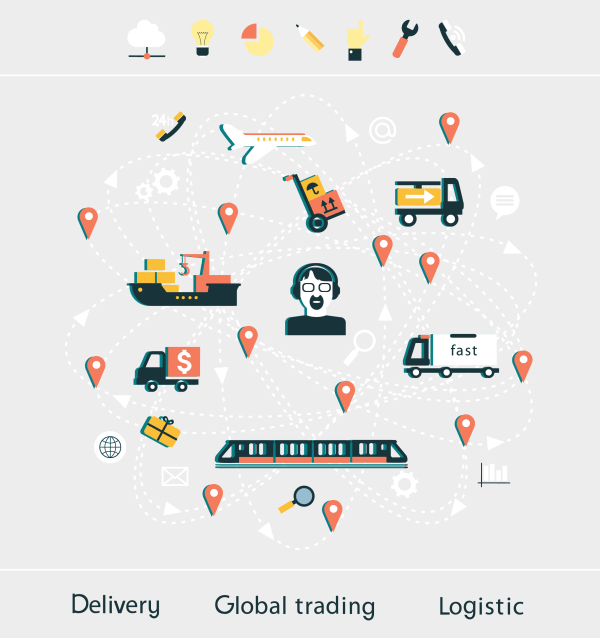Published January 28, 2016
By Don Anderson
Vice President Transportation Services, Tompkins International
An enterprise-wide global trade strategy increases supply chain cost and service performance for all trading partners and enables importers and exporters to comply with mandatory trade and security regulations. Companies that prioritize best-in-class global supply chain trade practices, maintain effective global transport / trade organizations and employ enabling technologies are the best positioned to capture the economic and brand benefits available in growing and changing global markets.
Research analytics and business trends centering on global supply chain management consistently point to the value of effective global trade planning and execution. In a recent study by Gartner and Amber Road of US importers and exporters improved import compliance was found to reduce US customs entry-related costs as much as 30%, more robust supply chain visibility improved speed to cash by 4-5 days, fully leveraging available free trade agreements reduced the cost of goods sold by up to 2% – 3%, and more effective management of global transportation and logistics functions resulted in savings of 5% or more. Individual client supply chain cost / performance improvement engagements confirm these types of business values alongside an ever increasing regulatory focus on the security of import flow of goods. High performing global supply chains typically exhibit many common traits, most notably:
Employ smart-sourcing practices and strategies. Taking into account total landed costs of goods, allowing for sourcing flexibility, and leveraging available trading bloc agreements and emerging market sources expands the options an importer has in terms of supply partners and the associated relationship of cost / quality / availability of goods. Leading supply chain practitioners consider global sourcing options as early as product design and specification stages to achieve the highest quality at the lowest landed cost including selection of the most trade-advantageous countries of origin, managing transportation and trade related costs in the import valuation of goods, and consideration of the applicability of strategic programs such as when and where goods are finished and first imported into the country of sale.
Utilize technology to optimize trade planning and execution. The prominence of global trade technology pacts in 2015 reinforces the critical role these technologies play in managing worldwide supply chain performance; the acquisition of ecVision by Amber Road, Descartes’ acquisitions of MK Data and CustomsInfo (the latter in 2014), and Infor’s purchase of GTNexus all attest to the growing demand by global enterprises for technologies and tools that help achieve more seamless flows of goods among trading partners, across borders, and through import / export countries’ regulatory agencies. In a recent study by Tompkins Supply Chain Consortium 52% of responding companies implemented trade software and tools in order to better control total landed costs while 67% of respondents employ global trade and logistics software and tools to improve the coordination of enterprise transportation, customer service, and operations planning with enterprise trade management. Complying with US and global trade agency security requirements was the most-cited reason (74% of respondents) for utilizing supply chain trade technologies to meet regulatory requirements and protect brand and company reputation.
Surpass the basics of regulatory compliance. Leading global supply chain owners understand the importance of protecting their right to easily move goods across international borders and they likewise understand the commercial value that is inherently part of compliance excellence. This is especially true today as new instances of global political instability and changing trade alliances drive US and other regulatory agencies to more closely monitor trade compliance. High on the list of must-have proficiencies within a global supply chain trade strategy are accurate commodity HS classifications and product valuations, adherence to mandatory import / export security filing protocols, broad use of import / export administrative efficiency improvement programs available in most top tier trading countries, and optimal use of available preferential trade programs. In addition to preserving import / export rights, those companies who excel in meeting regulatory requirements capture parallel commercial value in reduced duties, lower regulatory agency / entry costs, and improved end to end transportation performance.
In the coming business quarters expect to see increased focus on trade security and more rigorous regulatory compliance by commercial trading partners as well as at global regulatory enforcement agencies. Both in terms of effectively managing global supply chain transportation / trade costs and meeting regulatory demands, the visionary global traders will re-double efforts and initiatives to strengthen their global trade strategy thereby maintaining high levels of trading partner and customer satisfaction. Strengthened strategies will include smart sourcing policies and practices, the use of needs-based technologies to improve strategic and tactical decision-making, and heightened adherence to regulatory demands that will together yield new benefits to all parties along the global supply chain.
More Resources
- White paper: Dimensional Weight Pricing



